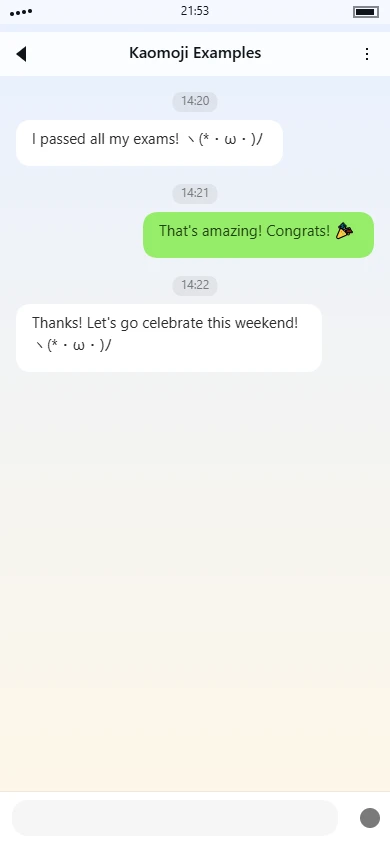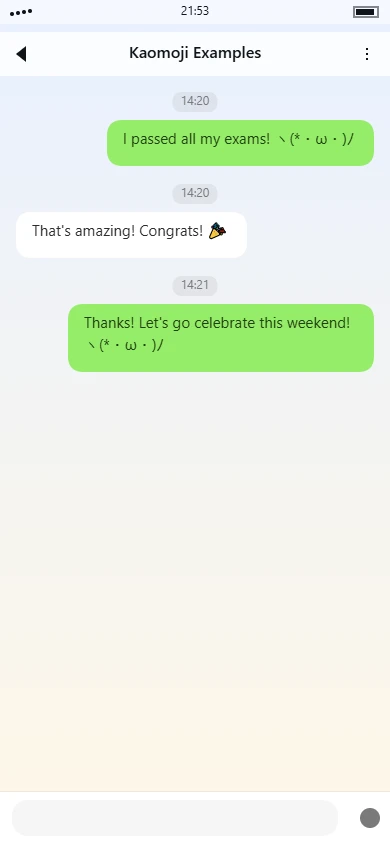(◕‿◕) kaomoji Meaning | Usage Tips

Overview
The kaomoji (◕‿◕) presents a stylized facial expression using a combination of parentheses and specialized Unicode characters to form a cheerful face. The overall structure consists of two circular eyes positioned within curved parentheses that serve as the face outline, with a distinctive curved mouth character placed between them. This arrangement creates a balanced, symmetrical appearance that conveys a sense of contentment and mild amusement.
Symbol Breakdown
- Parentheses as face outline: The opening and closing parentheses
and(
create a rounded facial boundary, giving the impression of a full, slightly plump face shape) - Circular eye characters: The
symbols represent eyes that are fully open and circular, suggesting attentiveness and positive engagement◕ - Curved mouth element: The
character forms a gentle upward curve that serves as the mouth, indicating a subtle smile without being overly exaggerated‿ - Symmetrical placement: The eyes are positioned at roughly equal distances from the mouth, creating visual balance and harmony in the expression
- Minimal character count: With only five characters total, the design achieves its expression through efficient use of symbolic elements
Emotion & Aesthetic Analysis
The emotional tone conveyed by (◕‿◕) falls into the category of gentle happiness or contented satisfaction. The expression lacks the intensity of more exaggerated happy kaomoji like (≧▽≦) or (^_^), instead presenting a more subdued and stable form of pleasure. The circular eyes contribute to an impression of innocence or mild curiosity, while the subtle smile suggests quiet contentment rather than overt excitement.
In terms of aesthetic qualities, this kaomoji employs a clean, geometric approach to facial representation. The circular eyes and curved mouth work together to create a cohesive visual language that feels both structured and organic. The spacing between elements is consistent, with the eyes positioned close enough to the facial boundaries to maintain readability while allowing the mouth to serve as a clear focal point. This kaomoji tends to be used in contexts where the sender wants to express positive sentiment without overwhelming intensity—situations like acknowledging a pleasant message, expressing mild agreement, or conveying general good will in digital communication.
Compared to similar happy-face kaomoji, (◕‿◕) occupies a middle ground between neutral and enthusiastic expressions. It's more emotionally present than (•_•) but less exuberant than (ᵔ◡ᵔ). The specific character choices—particularly the filled circular eyes—give it a slightly more modern and designed appearance compared to traditional smiley faces using colon and parenthesis combinations. This makes it well-suited for contexts where the sender wants to convey positivity while maintaining a degree of composure or sophistication in their digital expression.
Tag categories
Use tags to quickly understand this kaomoji.
Usage guide
Usage Guide for (◕‿◕)
The (◕‿◕) kaomoji is one of the most versatile and widely recognized text-based emoticons in digital communication. Characterized by its simple yet expressive round eyes and gentle smile, this emoticon conveys a range of positive emotions from genuine happiness and contentment to playful mischief and lighthearted approval. Its balanced facial features create a neutral-positive tone that works well across various contexts—from casual chats with friends to social media comments and gaming communities. Unlike more exaggerated emoticons, (◕‿◕) maintains a subtle charm that feels authentic rather than overly enthusiastic, making it suitable for both expressing personal feelings and responding to others' messages in a warm, approachable manner.
Common Use Cases
- Expressing quiet satisfaction after completing a task or solving a problem
- Reacting to cute animal photos or heartwarming stories shared by friends
- Showing gentle agreement in a group chat discussion without being too forceful
- Adding a friendly tone to constructive feedback or suggestions
- Celebrating small personal achievements like finishing a book or reaching a fitness goal
- Responding to good news from colleagues or family members in a supportive way
- Creating a welcoming atmosphere when greeting new members in online communities
- Softening requests or favors to make them sound more polite and considerate
- Accompanying witty remarks or clever observations in casual conversations
- Expressing patient understanding when someone shares minor frustrations
- Reacting to amusing memes or funny videos that elicit a genuine smile
- Maintaining positive engagement in lengthy text conversations
Example Conversations
-
Friend sharing good news
"Just got accepted into the graduate program I wanted!" "That's amazing news! (◕‿◕) So happy for you!"
-
Casual planning discussion
"Should we meet at the usual cafe around 3?" "Sounds perfect (◕‿◕) I'll bring those notes you wanted"
-
Reacting to shared content
"Check out this sunset photo I took yesterday" "Wow, the colors are breathtaking (◕‿◕) You have a great eye!"
-
Workplace coordination
"The presentation draft is ready for your review when you have time" "Thanks for the heads up (◕‿◕) I'll look it over this afternoon"
-
Gaming community interaction
"Finally beat that boss after 10 tries!" "Nice persistence! (◕‿◕) The next level gets even better"
-
Personal milestone sharing
"Just finished my first 5K run this morning" "That's a huge accomplishment (◕‿◕) You should be proud!"
Important Notes
- Avoid using (◕‿◕) in formal business communications, official emails, or serious discussions where a professional tone is required, as it may appear too casual or immature
- Be mindful that the subtle nature of this emoticon might sometimes be misinterpreted as passive-aggressive or sarcastic in certain contexts, especially when discussing sensitive topics
- Consider your relationship with the recipient—while universally friendly, (◕‿◕) works best with people you already have established rapport with rather than complete strangers in professional settings
- On platforms like Discord, Slack, and gaming communities, this emoticon is widely accepted and understood, but may appear differently on various devices due to font rendering differences
- The emotional weight of (◕‿◕) is generally lighter than more expressive emoticons like (^▽^) or (≧▽≦), making it better suited for everyday casual interactions rather than extreme excitement
- Cultural note: While universally recognizable in Western digital spaces, the specific interpretation may vary slightly across different online communities and age groups
Usage examples
Real conversation samples that feature this kaomoji.

Example 1

Example 2
Related kaomoji
You might also enjoy these kaomoji.